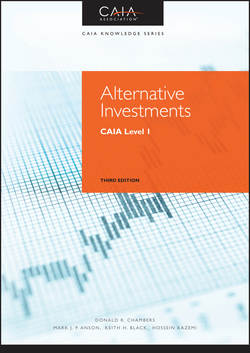Читать книгу Alternative Investments - Hossein Kazemi - Страница 63
На сайте Литреса книга снята с продажи.
PART One
Introduction to Alternative Investments
CHAPTER 4
Statistical Foundations
4.3 Covariance, Correlation, Beta, and Autocorrelation
4.3.1 Covariance
ОглавлениеThe covariance of the return of two assets is a measure of the degree or tendency of two variables to move in relationship with each other. If two assets tend to move in the same direction, they are said to covary positively, and they will have a positive covariance. If the two assets tend to move in opposite directions, they are said to covary negatively, and they will have a negative covariance. Finally, if the two assets move independently of each other, their covariance will be zero. Thus, covariance is a statistical measure of the extent to which two variables move together. The formula for covariance is similar to that for variance, except that instead of squaring the deviations of one variable, such as the returns of fund i, the formula cross multiplies the contemporaneous deviations of two different variables, such as the returns of funds i and j:
(4.15)
where Ri is the return of fund i, μi is the expected value or mean of Ri, Rj is the return of fund j, and μj is the expected value or mean of Rj.
The covariance is the expected value of the product of the deviations of the returns of the two funds. Covariance can be estimated from a sample using Equation 4.16:
where Rit is the return of fund i in time t, and i is the sample mean return of Rit, and analogously for fund j. T is the number of time periods observed.
The estimation of the covariance for a sample of returns from a market index fund and a real estate fund is shown in Exhibit 4.2. Column 8 multiplies the fund's deviation from its mean return by the index's deviation from its mean return. Each of the products of the deviations is then summed and divided by n − 1, where n is the number of observations. The result is the estimated covariance between the returns over the sample period, shown near the bottom right-hand corner of Exhibit 4.2.
Exhibit 4.2 Covariance, Correlation, and Beta
Source: Bloomberg.
Because covariance is based on the products of individual deviations and not squared deviations, its value can be positive, negative, or zero. When the return deviations are in the same direction, meaning they have the same sign, the cross product is positive; when the return deviations are in opposite directions, meaning they have different signs, the cross product is negative. When the cross products are summed, the resulting sum generates an indication of the overall tendency of the returns to move either in tandem or in opposition. Note that the table method illustrated in Exhibit 4.2 simply provides a format for solving the formula, which can be easily solved by software. Covariance is used directly in numerous applications, such as in the classic portfolio theory work of Markowitz.
